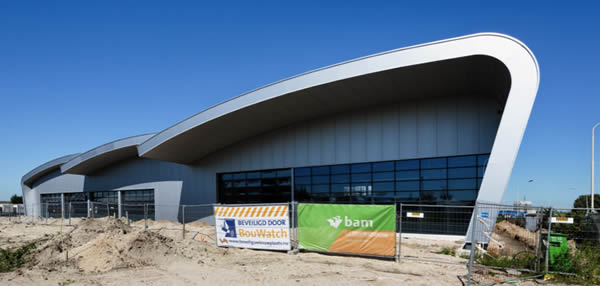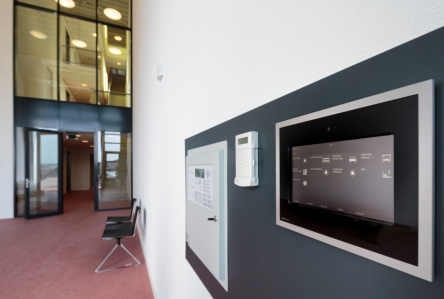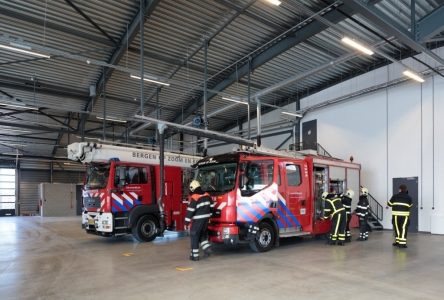 By Remco Hoveling, BAM Techniek
By Remco Hoveling, BAM Techniek
What could be a greater contrast than water and fire? For the fire department in Bergen op Zoom, both are equally important and have been incorporated in a special architectural design. Built on the exact spot where the former city wall held back the sea water, the new fire department building reflects its connection with past in the design of its modern roof which takes the form of three large waves. These metal waves also allow rainwater, which will be used to put out fires, to be collected in an underground tank, and the water level can be seen by passersby thanks to an LED display.

The reuse of water is not the only clever feature of this building. The electrical installation is also smart, allowing the firefighters to concentrate on their core task in emergency situations and allowing them to get to work more quickly and safely.
We were commissioned by the municipality of Bergen op Zoom in June 2013 to design and build this project and maintain the building and its installations for the next 20 years.
The Brief
One of the most important requirements was, in the case of a call out, to have the fire crew dispatched within one minute – because every second counts when there is a fire. Another requirement was to save energy wherever possible.
Prior to the invitation to tender for the new construction, the city and fire brigade visited various fire stations to learn from their experiences and explore all of the options. The same range of functions could have been realised using conventional methods, but we decided to use a building automation system that allows additional functions to be integrated in future.
The Solution
Given our responsibility for the building and installation for the next two decades, we decided to use KNX for the building automation, as it is an international standard, uses a bus structure and is robust. The functions that the fire department demanded would, in a conventional installation, have required many duplicate contacts, auxiliary relays and individual control cabinets, and with so many connections, the potential for something to go wrong would have been great. With KNX however, we could minimise the likelihood of a system malfunction by using high-quality components and controlling the system centrally. This also made it cheaper than a conventional installation.

Saving Time
When the alarm goes off, the bus system ensures that a number of auxiliary functions are activated so that precious seconds are saved. For example, the lights go on automatically in the firefighters’ sleeping and changing areas, the rolling garage doors open and the gas exhaust extraction system is switched on. The gate to the property will be open by the time the fire trucks drive off and the lights at the nearby intersection will warn other traffic to give way. Cooking apparatus and other devices that are still working, are turned off automatically.

Saving Energy
Under normal conditions, the building automation controls all indoor and outdoor lighting depending on presence, the amount of natural light or time, using a combination of presence detectors and a weather station. It reports alarm notifications from toilets for the disabled, and shows all controls and faults from the various subsystems.
The heating system comprises underfloor heating, a cooling system for the summer, and zone heating for peak demand times in winter. The CO2-controlled ventilation provides fresh air, but is not fully integrated into KNX due to time constraints, although it does send all messages to the central control system. The efficient mechanical installation and the efficient lighting and heating control systems, in combination with high-quality insulation have resulted in the building having an energy coefficient which is 30% below the legal standard for new construction in The Netherlands. Indeed the fire station has become a role model because of this.
Conclusion
We started with a typical installation whereby only the lighting was initially linked to the control system, but as we looked at other aspects of the building’s operation, we recognised that, using KNX, a solution could be found to every problem, and we could easily scale up the system. The result is a sound and sustainable building with technical systems that ensure security, value, and faster despatch of the fire crew. Indeed this project demonstrated how KNX can be integrated with many different technologies, and is still expanding as the client sees opportunities to add value by linking the installation with more equipment.
What we did here is not unique, but we did take full advantage of the flexibility that KNX offers, and we are all very satisfied with the result.
Equipment List
Lighting system.
Weather station.
Linking with C2000 system and the proprietary system of the fire department,
where the serious reports come in case of a fire for example.
Integration with traffic lights.
Integration with rolling grilles.
Integration with sliding doors.
Integration with KWH meters.
Incorporation of fault signals.
Mechanical installation of fault systems.
Several drivers.
MIVA signalling and drivers.
GIRA touchscreen.
Installation of fans.
Remco Hoveling is the Chief Engineer for BAM Techniek – Regio West, a subsidiary of Royal BAM Group that designs, installs, operates and manages technical equipment for construction, industrial, housing and infrastructure.












